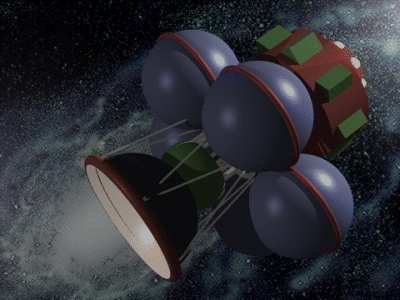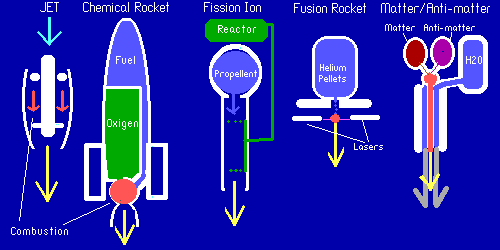pop up description layer
HOME
Cryptozoology UFO Mysteries Aviation Space & Time Dinosaurs Geology Archaeology Exploration 7 Wonders Surprising Science Troubled History Library Laboratory Attic Theater Store Index/Site Map Cyclorama
Search the Site: |
|
StarShip Design
Power and propellant are primary concerns when designing a starship. Too little of either means the vessel will be incapable of making the immense journey across the interstellar void. Too much, if it increases the mass of the vessel, may render the ship too heavy to accelerate to the necessary speeds. Most spaceships we have today, or envision in the near future, are designed around a basic principle of physics: For every action there is an equal and opposite reaction. A jet plane, by forcing the hot gases of combustion out of the rear of it's engines, moves the aircraft forward through the air. A rocket does the same thing, but since it carries both the fuel and the oxygen to burn it, in internal tanks, the rocket can operate in the vacuum of space. In a chemical rocket the fuel provides both the power and the propellant. As the fuel burns and expands it provides the power that then thrusts the waste products of the burning gases out the rear of the rocket. The problem with the chemical rocket engines we use now is that they are relatively inefficient and too much fuel is needed to take a ship great distances. New designs attempt to give spaceships greater range by increasing the power of the engine without increasing size or mass. One possible power source for future deep spaceships may be nuclear reactors. While nuclear fission reactors may produce potentially hazardous by-products that are environmental problems on Earth, they do produce a lot of power from a very small amount of fuel. The amount of uranium used up by a nuclear submarine traveling around the globe is about the size of a golf ball. A nuclear fission reactor on board a spaceship would produce lots of power, in the form of heat and electricity, but no propellant. In order to make the ship go forward something must be expelled out the back. Propellant tanks filled with something inert like xenon would have to be carried on board. The electric power from the reactor could then be used to force charged particles (ions) of the propellant out the exhaust and this would move the ship forward. NASA has a deep space probe in planning using this design. It would leave our solar system and travel into space 1000 times more distant than the Earth is to the Sun, some 93,000,000,000 miles, to make astronomical observations. Even with a fission reactor the amount of propellant needed to push a ship at high speed between the stars is still a problem. We can lessen the amount of propellant we need, though, by increasing the speed at which it is expelled while keeping the spaceship the same size. To increase the exhaust speed of the propellant requires more power. To increase the power the nuclear fission reactor can be replaced with a nuclear fusion reactor. A fusion reactor can generate five times the energy from the same amount of fuel. The extra power can be used to expel the propellant faster giving the ship more range or more speed. Unfortunately, we have yet to figure out how to make a fusion reaction work on Earth, except in the heart of an H-bomb explosion. Some fusion spaceship engine designs actually use many "micro-explosions" to push the vessel forward. Tiny pellets of helium-3 would be detonated, each a miniature H-bomb, by powerful lasers 250 times a second. Using a design like this a velocity of 12.2 percent of the speed of light might be obtained during an interstellar voyage. The ultimate power source for a spaceship is a matter/anti-matter reaction. Often mentioned as the power source in the popular Star Trek television series and movies, it really exists. When a matter and anti-matter particles meet their total mass is turned into energy. This means that a matter/anti-matter engine would produce two hundred times the power of a fusion engine for the same amount of fuel. There may be ways, other than expelling propellant, we can move spaceships through space. Scientists have speculated that if we ever gain an understanding of exactly how gravity works, and how to generate it artificially, we may be able to build "anti-gravity" engines that would allow a ship to levitate or move away from a gravity source like the Earth or Sun. Different engine designs. Copyright Lee Krystek 1996. All Rights Reserved. |
|
Related Links |
|
|




 Build
a Balloon Rocket
Build
a Balloon Rocket
